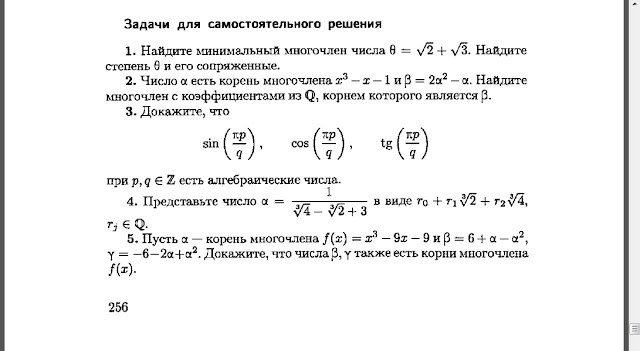The title of this post is the one from the source that inspired me: a draft of Lecture Notes of H.M. Khudaverdian , "Galois theory", Manchester, Autumn 2006 (version 16 XII 2006). See pages 76-77.
My concern for this problem appeared exactly one year ago when I saw the Facebook post of Mahan Gholami. I have published about them here and here, but now we will give a treatment of the general case.
As an irony, I posted the proposed problem on our Facebook Page and received all kinds of responses.
Let's take for example the equation $x^3-1=0$. Its roots are $x_1=1,\;x_{2,3}=\frac{-1\pm \imath \sqrt{3}}{2}.$ The $x_2$ and $x_3$ cannot be rationally expressed in terms of $x_1=1$. However, if we denote by $\xi$ one of the roots $x_{2,3}$ we have
$$\xi,\;\xi^2,\;-\xi-\xi^2$$
as the complete list of roots. In our situation it will be seen that we do not have to choose a preferential root, but the expressions are possible whatever the chosen root. The above situation occurs because the polynomial $X^3-1$ is not irreducible.
The situation is clarified by the Proposition (not named as such) on page 35 of the work cited at the beginning. Combining the ideas from there we enunciate:
Proposition Let $f$ be irreducible cubic polynomial over $\mathbb{Q}$.
If (and only if) square root of its discriminant are rational number, then
the roots of equation $f(x)=0$ are rationally expressible via each other.
Remark If one of the roots is $\alpha$ then, because the degree of expansion
of the decomposition field of the polynomial will be equal to 3, the other
roots have the expression
$$l+m\cdot \alpha +n \cdot \alpha^2 \tag{0}$$
with the coefficients $l,\;m,\;n\;\in \mathbb{Q}.$
We will present here only the METHOD by which, in the given case, the stated expression can be found.
Without losing generality, we assume $f=X^3+p\cdot X+q \;\in \mathbb{Q}[X]$ irrreducible. Its roots $x_{1,2,3}\;\in \mathbb{C}$ satisfy the condition
$$x_1+x_2+x_3=0. \tag{1}$$
Let
$$d=(x_1-x_2)(x_2-x_3)(x_3-x_1) \tag{2}$$
and $D=d^2$ its discriminant. Here
$$D=-4p^3-27q^2 .\tag{3}$$
If we denote by $\alpha$ one of the roots, let it be $x_1$, we will show that the others are expressed by
$$x_{2,3}=\frac{-3\alpha^3-p\alpha \pm \sqrt{D}}{6\alpha^2+2p}.\tag{4}$$
From (1) and (2) we have the equation
$(\alpha-x_2)(x_2+x_2+\alpha)(-x_2-\alpha-\alpha)=d$
which is written after multiplications
$$2x_2^3+3\alpha x_2^2-3\alpha^2x_2-d-2\alpha^3=0. \tag{5}$$
On the other hand, from the second Vieta's formula $x_1x_2+x_2x_3+x_3x_1=p$ we deduce $\alpha x_2+\alpha (-x_2-\alpha)+x_2(-x_2-\alpha )=p$, so
$$x_2^2+\alpha x_2 +\alpha ^2+p=0. \tag{6}$$
Multiplying equation (6) by $2x_2+\alpha$ we get
$$2x_2^3+3\alpha x_2^2+(3\alpha^2+2p) x_2+3\alpha^3+p \alpha =0. \tag{7}$$
Subtracting the equations (7) and (5) results
$$(6\alpha^2+2p)x_2+\alpha^3+p\alpha +d+2\alpha^3=0$$
where from
$$x_2=\frac{-3\alpha^3-p\alpha -d}{6\alpha^2+2p},$$
and then $x_3=-x_2-\alpha=\frac{3\alpha^2+p\alpha+d -6\alpha^3-2p\alpha}{6\alpha^2+2p}=\frac{-3\alpha^3-p\alpha+d}{6\alpha^2+2p}$ i.e. exactly formula (4).
$\blacksquare$
REMARK CiP
The fact that formula (4) can be expressed in the form (0) results from the following:
All powers of $\alpha$ have the form (0) :
$\alpha^3=-p \cdot \alpha -q,$
$\alpha ^4=-p \cdot \alpha^2-q \cdot \alpha,$ an so on...;
more, from $\alpha^3+p\alpha+q=0\;\;\Rightarrow\; \alpha(\alpha^2+p)=-q$ so
$\frac {1}{\alpha}=-\frac{1}{q} \cdot \alpha^2-\frac{p}{q}$.
Moreover, any rational expression $R(\alpha)=\frac{P(\alpha)}{Q(\alpha)}$ with $P,\;Q\in \mathbb{Q}[X]$ can be reduced first to one of the form $\frac{P_1(\alpha)}{Q_1(\alpha)}$ with degree polynomials $P_1$ and $Q_1$ at most 2. Then to the form (0), for example with the method of undetermined coefficients.
Let's try $\frac{1}{6\alpha^2+2p}$ that appears in formula (4).
$\frac{1}{6\alpha^2+2p}=l+m \cdot \alpha +n \cdot \alpha^2\;\;\Leftrightarrow$
$\Leftrightarrow\;\;1=(l+m\alpha+n\alpha^2) \cdot (6\alpha^2+2p)\;\;\Leftrightarrow$
$\Leftrightarrow \;\;1= 6l\alpha^2+2pl+6m \alpha^3+2mp\alpha+6n \alpha^4+2pn\alpha^2\;\;\Leftrightarrow$
$\Leftrightarrow\;\;1=6l\alpha^2+2pl+6m(-p\alpha-q)+2mp\alpha+6n(-p\alpha^2-q\alpha)+2pn\alpha^2\;\;\Leftrightarrow$
$\Leftrightarrow\;\;1=\alpha^2 \cdot(6l-4pn) +\alpha \cdot (-4pm-6qn)+(2pl-6qm).$
Let's then impose the requirements
\begin{cases}6l-4pn=0\;,\\-4pm-6qn=0\;,\\2pl-6qm=1 \;.\end{cases}
Solving this system of equations we get
$$n=\frac{3p}{4p^3+27q^2},\;m=-\frac{9q}{2(4p^3+27q^2)},\;l=\frac{2p^2}{4p^3+27q^2}.$$
<end REM>


